Pelletization of Post-Harvest Tobacco Waste and Investigation of Flue Gas Emissions from Pellet Combustion
Abstract
1. Introduction
2. Materials and Methods
2.1. Feedstock
2.2. Methods
2.2.1. Feedstock Property Determination
2.2.2. Pelletization Process and Pellets’ Quality Determination
2.2.3. Combustion Tests and Flue Gas Analysis
3. Results and Discussion
3.1. Feedstock Properties
3.2. Pelletization Tests
3.3. Combustion Tests
4. Conclusions
Author Contributions
Funding
Conflicts of Interest
Nomenclature
| Symbol | Description |
| LHV | lower heating value (MJ·kg−1) |
| HHV | higher heating value (MJ·kg−1) |
| w | moisture content (wt.%) |
| n | pelletizer’s matrix rotational speed (rpm) |
| Zs1 | the actual chemical content in the exhaust gas (%,mg·Nm−3) |
| Zs2 | content of the chemical compounds in the exhaust gas for a given oxygen content (%, mg·Nm−3) |
| O2′ | set value of the oxygen content in the exhaust (%) |
| O2″ | actual oxygen content in the exhaust gas (%) |
| FVI | fuel value index |
| λ | excess air factor (-) |
| ρ | pellet’s density (kg·m−3) |
| Px | pellet’s kinetic durability (%) |
| N | granulator’s power demand (kW) |
| wt.% | weight percent |
| a.r. | as received |
| d.b. | dry basis |
References
- Liu, Z.; Quek, A.; Balasubramanian, R. Preparation and characterization of fuel pellets from woody biomass, agro-residues and their corresponding hydrochars. Appl. Energy 2014, 113, 1315–1322. [Google Scholar] [CrossRef]
- Ugwua, S.N.; Enweremadu, C.C. Effects of pre-treatments and co-digestion on biogas production from Okra waste. J. Renew. Sustain. Energy 2019, 11, 013101. [Google Scholar] [CrossRef]
- Łochyńska, M.; Frankowski, J. The biogas production potential from silkworm waste. J. Waste Manag. 2018, 79, 564–570. [Google Scholar] [CrossRef] [PubMed]
- Oniszczuk, T.; Pilawka, R. Effect of cellulose fibers on thermal strength of thermoplastic starch. Przem. Chem. 2013, 2, 265–269. [Google Scholar]
- Czekała, W.; Bartnikowska, S.; Lewicka, A.; Bugała, A.; Zbytek, Z.; Lewicki, A. Economic and energy efficiency of the solid biofuels produced from digested pulp. MATEC Web Conf. 2016, 60, 04005. [Google Scholar] [CrossRef]
- Obidziński, S.; Dołżyńska, M.; Kowczyk-Sadowy, M.; Jadwisieńczak, K.; Sobczak, P. Densification and Fuel Properties of Onion Husks. Energies 2019, 12, 4687. [Google Scholar] [CrossRef]
- Abedi, A.; Dalai, A.K. Study on the quality of oat hull fuel pellets using bio-additives. Biomass Bioenergy 2017, 106, 166–175. [Google Scholar] [CrossRef]
- Dołżyńska, M.; Obidziński, S.; Kowczyk-Sadowy, M.; Krasowska, M. Densification and Combustion of Cherry Stones. Energies 2019, 12, 3042. [Google Scholar] [CrossRef]
- Braadbaart, F.; Marinova, E.; Sarpaki, A. Charred olive stones: Experimental and archaeological evidence for recognizing olive processing residues used as fuel. Veg. Hist. Archaeobotany 2016, 25, 415–430. [Google Scholar] [CrossRef]
- Gong, C.; Lu, D.; Wang, G.; Tabil, L.G.; Wang, D. Compression Characteristics and Energy Requirement of Briquettes Made from a Mixture of Corn Stover and Peanut Shells. BioResources 2015, 10, 5515–5531. [Google Scholar] [CrossRef]
- Stasiak, M.; Molenda, M.; Bańda, M.; Wiącek, J.; Parafiniuk, P.; Gondek, E. Mechanical and combustion properties of sawdust—Straw pellets blended in different proportions. Fuel Process. Technol. 2017, 156, 366–375. [Google Scholar] [CrossRef]
- Ishii, K. Influence of moisture content, particle size and forming temperature on productivity and quality of rice straw pellets. Waste Manag. 2014, 34, 2621–2626. [Google Scholar] [CrossRef]
- Husain, Z.; Zainac, Z.; Abdullah, Z. Briquetting of palm bre and shell from the processing of palm nuts to palm oil. Biomass Bioenergy 2002, 22, 505–509. [Google Scholar] [CrossRef]
- Barbanera, M.; Lascaro, E.; Stanzione, V.; Esposito, A.; Altieri, R.; Bufacchi, M. Characterization of pellets from mixing olive pomace and olive tree pruning. Renew. Energy 2016, 185–191. [Google Scholar] [CrossRef]
- FAOSTAT. Available online: http://www.fao.org/faostat/en/ (accessed on 3 January 2020).
- Wang, J.; Lu, D.; Zhao, H.; Ling, X.; Jiang, B.; Ouyang, P. Application of response surface methodology optimization for the production of caffeic acid from tobacco waste. South Afr. J. Enol. Vitic. 2009, 8, 1416–1424. [Google Scholar] [CrossRef]
- Mumba, P.P.; Phiri, R. Environmental impact assessment of tobacco waste disposal. Int. J. Environ. Res. 2008, 2, 225–230. [Google Scholar]
- Qin, Z.; Sun, M.; Luo, X.; Zhang, H.; Xie, J.; Chen, H.; Yang, L.; Shi, L. Life-cycle assessment of tobacco stalk utilization. Bioresour. Technol. 2018, 265, 119–127. [Google Scholar] [CrossRef]
- Chen, H.; Guo, Y.; Wang, F.; Wang, G.; Qi, P.; Guo, X.; Dai, B.; Yu, F. An activated carbon derived from tobacco waste for use as a supercapacitor electrode material. New Carbon Mater. 2016, 32, 592–599. [Google Scholar] [CrossRef]
- Czerwińska, E.; Koronowski, A.; Stankiewicz, D. The Tobacco Industry and the Issue of a State Monopoly; Report No. 61; Chancellery of the Polish Parliament, The Research Office: Warsaw, Poland, 1994. [Google Scholar]
- Cai, J.; Li, B.; Chen, C.; Wang, J.; Zhao, M.; Zhang, K. Hydrothermal carbonization of tobacco stalk for fuel application. Bioresour. Technol. 2016, 220, 305–311. [Google Scholar] [CrossRef]
- Strezov, V.; Popovic, E.; Filkoski, R.V.; Shah, P.; Evans, T. Assessment of the Thermal Processing Behavior of Tobacco Waste. Energy Fuels 2012, 26, 5930–5935. [Google Scholar] [CrossRef]
- Yang, Y.; Li, T.; Jin, S.; Lin, Y.; Yang, H. Catalytic pyrolysis of tobacco rob: Kinetic study and fuel gas produced. Bioresour. Technol. 2011, 102, 11027–11033. [Google Scholar] [CrossRef] [PubMed]
- Glarborg, P.; Miller, J.A.; Ruscic, B.; Klippenstein, S.J. Modeling nitrogen chemistry in combustion. Prog. Energy Combust. Sci. 2018, 67, 31–68. [Google Scholar] [CrossRef]
- Zając, G.; Szyszlak-Bargłowicz, J.; Gołębiowski, W.; Szczepanik, M. Chemical Characteristics of Biomass Ashes. Energies 2018, 11, 2885. [Google Scholar] [CrossRef]
- Obidziński, S.; Joka, M.; Luto, E.; Bieńczak, A. Research of the densification process of post-harvest tobacco waste. J. Res. Appl. Agric. Eng. 2017, 62, 149–154. [Google Scholar]
- Cong, K.; Han, F.; Zhang, Y.; Li, Q. The investigation of co-combustion characteristics of tobacco stalk and low rank coal using a macro-TGA. Fuel 2019, 237, 126–132. [Google Scholar] [CrossRef]
- Cai, J.; Xu, D.; Dong, Z.; Yu, X.; Yang, Y.; Banks, S.W.; Bridgwater, A.V. Processing thermogravimetric analysis data for isoconversional kinetic analysis of lignocellulosic biomass pyrolysis: Case study of corn stalk. Renew. Sustain. Energy Rev. 2018, 82, 2705–2715. [Google Scholar] [CrossRef]
- Dołżyńska, M.; Obidziński, S.; Simiński, P. Evaluation of granulates from hemp sowing waste as a biofuel. Przem. Chem. 2018, 97, 686–688. [Google Scholar] [CrossRef]
- Obidzinski, S. Pelletisation of biomass waste with potato pulp content. Int. Agrophys. 2014, 28, 85–91. [Google Scholar] [CrossRef][Green Version]
- Tumuluru, J.S.; Fillerup, E. Briquetting characteristics of woody and herbaceous biomass blends: Impact on physical properties, chemical composition, and calorific value. Biofuel Bioprod. Biorefin 2020, 14, 1105–1124. [Google Scholar] [CrossRef]
- Serrano, C.; Monedero, E.; Lapuerta, M.; Portero, H. Effect of moisture content, particle size and pine addition on quality parameters of barley straw pellets. Fuel Process. Technol. 2011, 92, 699–706. [Google Scholar] [CrossRef]
- Mediavilla, I.; Fernández, M.J.; Esteban, L.S. Optimization of pelletisation and combustion in a boiler of 17.5 kWth for vine shoots and industrial cork residue. Fuel Process. Technol. 2009, 90, 621–628. [Google Scholar] [CrossRef]
- Nasrin, A.B.; Ma, A.N.; Mohammad, S.; Rohaya, M.H.; Azali, A.; Zainal, Z. Oil palm biomass as potential substitution raw materials for commercial biomass briquettes production. Am. J. Appl. Sci. 2008, 5, 179–183. [Google Scholar] [CrossRef]
- Stahl, M.; Berghel, J. Energy efficient pilot-scale production of wood fuel pellets made from a raw material mix including sawdust and rapeseed cake. Biomass Bioenergy 2011, 35, 4849–4854. [Google Scholar] [CrossRef]
- Miranda, M.T.; Arranz, J.I.; Rojas, S.; Montero, I. Energetic characterization of densified residues from Pyrenean oak forest. Fuel 2009, 88, 2106–2112. [Google Scholar] [CrossRef]
- Miranda, T.; Arranz, J.I.; Montero, I.; Román, S.; Rojas, C.V.; Nogales, S. Characterization and combustion of olive pomace and forest residue pellets. Fuel Process. Technol. 2012, 103, 91–96. [Google Scholar] [CrossRef]
- Obidziński, S.; Dołżyńska, M.; Bobowik, G.; Bieńczak, A. Agglomeration process of post-production tobacco waste. J. Res. Appl. Agric. Eng. 2018, 63, 40–45. [Google Scholar]
- PN-R-64798:2009. Feeds—Determination of Grinding; Polski Komitet Normalizacyjny = Polish Committee for Standardization: Warsaw, Poland, 2009. [Google Scholar]
- Obidziński, S.; Hejft, R. Granulowanie odpadów pochodzenia roślinnego w układzie roboczym granulatora. J. Res. Appl. Agric. Eng. 2013, 58, 133–138. [Google Scholar]
- PN-EN ISO 18134:2017. Solid Biofuels—Determination of Moisture Content—Drying Method—Part 2: Total Moisture—Simplified Method; ISO: Geneve, Switzerland, 2017. [Google Scholar]
- PN-EN ISO 18123:2016. Solid Biofuels—Determination of Volatile Matter; ISO: Geneve, Switzerland, 2016. [Google Scholar]
- PN-EN ISO 18122:2016. Solid Biofuels—Determination of Ash Content; ISO: Geneve, Switzerland, 2016. [Google Scholar]
- PN-EN ISO 16948:2016. Solid Biofuels—Determination of Total Carbon, Hydrogen and Nitrogen Content; ISO: Geneve, Switzerland, 2016. [Google Scholar]
- PN-EN ISO 16994:2016. Solid Biofuels—Determination of Total Sulfur and Chlorine Content; ISO: Geneve, Switzerland, 2016. [Google Scholar]
- Dołżyńska, M.; Obidziński, S.; Piekut, J.; Yildiz, G. The Utilization of Plum Stones for Pellet Production and Investigation of Post-Combustion Flue Gas Emissions. Energies 2020, 13, 5107. [Google Scholar] [CrossRef]
- PN-ISO 587:2000. Solid Fuels—Determination of the Chlorine Content Using the Eschki Mixture; ISO: Geneve, Switzerland, 2000. [Google Scholar]
- PN-ISO 1928:2002. Solid Fuels—Determination of Heat of Combustion by Calorimetric Bomb Method Andcalorific Value Calculation; ISO: Geneve, Switzerland, 2002. [Google Scholar]
- Wróbel, M.; Mudryk, K.; Jewiarz, M.; Głowacki, S.; Tulej, W. Characterization of Selected Plant Species in Terms of Energetic Use. Renew. Energy SourcesEng. Technol. Innov. 2018, 671–681. [Google Scholar] [CrossRef]
- Obidziński, S.; Hejft, R. Briquetting waste material in a prototype pelletizing and briquetting arrangement. Agric. Eng. 2015, 1, 107–116. [Google Scholar] [CrossRef]
- Obidziński, S.; Dołżyńska, M.; Stasiełuk, W. Production of fuel pellets from a mixture of sawdust and rye bran. In IOP Conference Series: Earth and Environmental Science; IOP Publishing: Bristol, UK, 2019. [Google Scholar] [CrossRef]
- PN-EN ISO 17831-1:2016-02. Solid Biofuels—Determination of the Mechanical Strength of Pellets and Briquettes—Part 1: Pellets; ISO: Geneve, Switzerland, 2016. [Google Scholar]
- Dołżyńska, M.; Obidziński, S. Wpływ dodatku zużytego oleju spożywczego na efekty spalania osadów ściekowych. Przem. Chem. 2017, 96, 1848–1851. [Google Scholar] [CrossRef]
- Wandrasz, J.W.; Wandrasz, A.J. Paliwa Formowane Biopaliwa i Paliwa z Odpadów w Procesach Termicznych; Wydawnictwo Seidel-Przywecki: Warszawa, Poland, 2006. [Google Scholar]
- Lazaroiu, G.; Pop, E.; Negreanu, G.; Pisa, I.; Mihaescu, L.; Bondrea, A.; Berbece, V. Biomass combustion with hydrogen injection for energy applications. Energy 2017, 127, 351–357. [Google Scholar] [CrossRef]
- Yahya, M.A.; Al-Qodah, Z.; ZanariahNgah, C.W. Agricultural bio-waste materials as potential sustainable precursors used for activated carbon production: A review. Renew. Sustain. Energy Rev. 2015, 46, 218–235. [Google Scholar] [CrossRef]
- Phyllis2. Available online: https://phyllis.nl/Home/Help (accessed on 20 July 2020).
- ISO 17225-6:2014. Solid Biofuels—Fuel Specifications and Classes—Part 6: Graded Non-Woody Pellets; ISO: Geneve, Switzerland, 2014. [Google Scholar]
- Karbowniczak, A.; Hamerska, J.; Wróbel, M.; Jewiarz, M.; Nęcka, K. Evaluation of Selected Species of Woody Plants in Terms of Suitability for Energy Production. Renew. Energy Sources Eng. Technol. Innov. 2018, 735–742. [Google Scholar] [CrossRef]
- Peševski, M.D.; Iliev, B.M.; Živković, D.L.; Jakimovska-Popovska, V.T.; Srbinoska, M.A.; Filiposki, B.K. Possibilities for utilisation of tobacco stems for production of energetic briquettes. J. Agric. Sci. Technol. 2010, 55, 45–54. [Google Scholar] [CrossRef]
- Obidziński, S. Utilization of post-production waste of potato pulp and buckwheat hulls in the form of pellets. Pol. J. Environ. Stud. 2014, 23, 1391–1395. [Google Scholar]
- Niedziółka, I.; Zuchniarz, A. Analiza energetyczna wybranych rodzajów biomasy pochodzenia roślinnego. Motrol 2006, 8A, 232–237. [Google Scholar]
- Maj, G.; Piekut, J. Comparing emission factors and physicochemical properties of waste-biomass leaves of selected species of trees. Pol. J. Environ. Stud. 2018, 27, 2155–2162. [Google Scholar] [CrossRef]
- Szyszlak-Bargłowicz, J.; Zając, G.; Piekarski, W. Energy biomass characteristics of chosen plants. Int. Agrophys. 2012, 26, 175–179. [Google Scholar] [CrossRef]
- Zwiślak, K.; Sobczak, P.; Panasiewicz, M.; Mazur, J.; Nadulski, R.; Starek, A. Wpływ wielkości frakcji otrąb pszennych na jakość granulatu. InżynieriaPrzetwórstwa Spożywczego 2014, 3, 25–28. [Google Scholar]
- Larsson, S.H.; Thyrel, M.; Geladi, P.; Lestander, T.A. High quality biofuel pellet production from pre-compacted low density raw material. Bioresour. Technol. 2008, 99, 7176–7182. [Google Scholar] [CrossRef] [PubMed]
- Miranda, M.T.; Sepúlveda, F.J.; Arranz, J.I.; Montero, I.; Rojas, C.V. Analysis of pelletizing from corn cob waste. J. Environ. Manag. 2018, 228, 303–311. [Google Scholar] [CrossRef] [PubMed]
- Sepúlveda, F.J.; Arranz, J.I.; Miranda, M.T.; Montero, I.; Rojas, C.V. Drying and Pelletizing Analysis of Waste from Cork Granulated Industry. Energies 2018, 11, 109. [Google Scholar] [CrossRef]
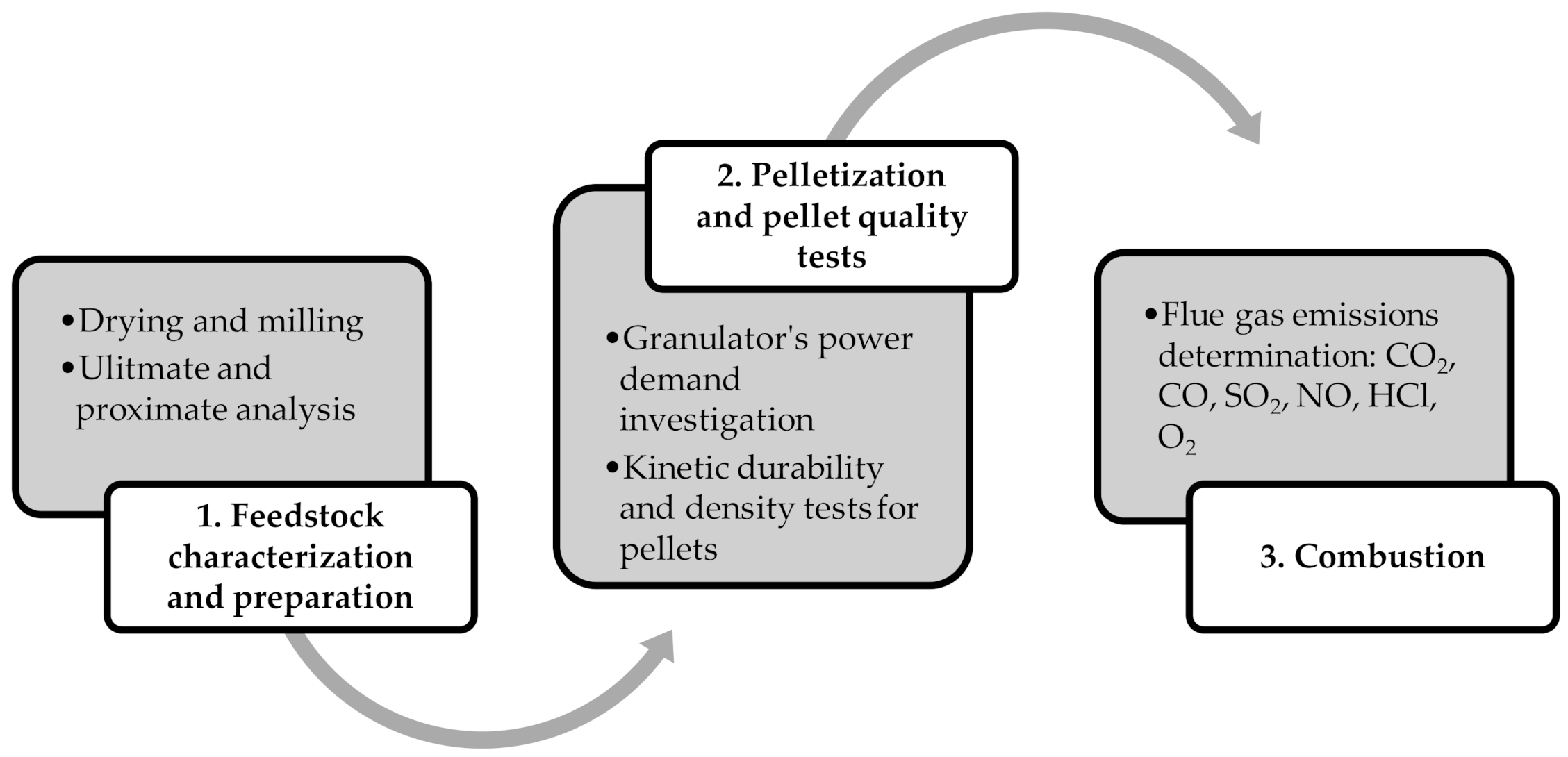
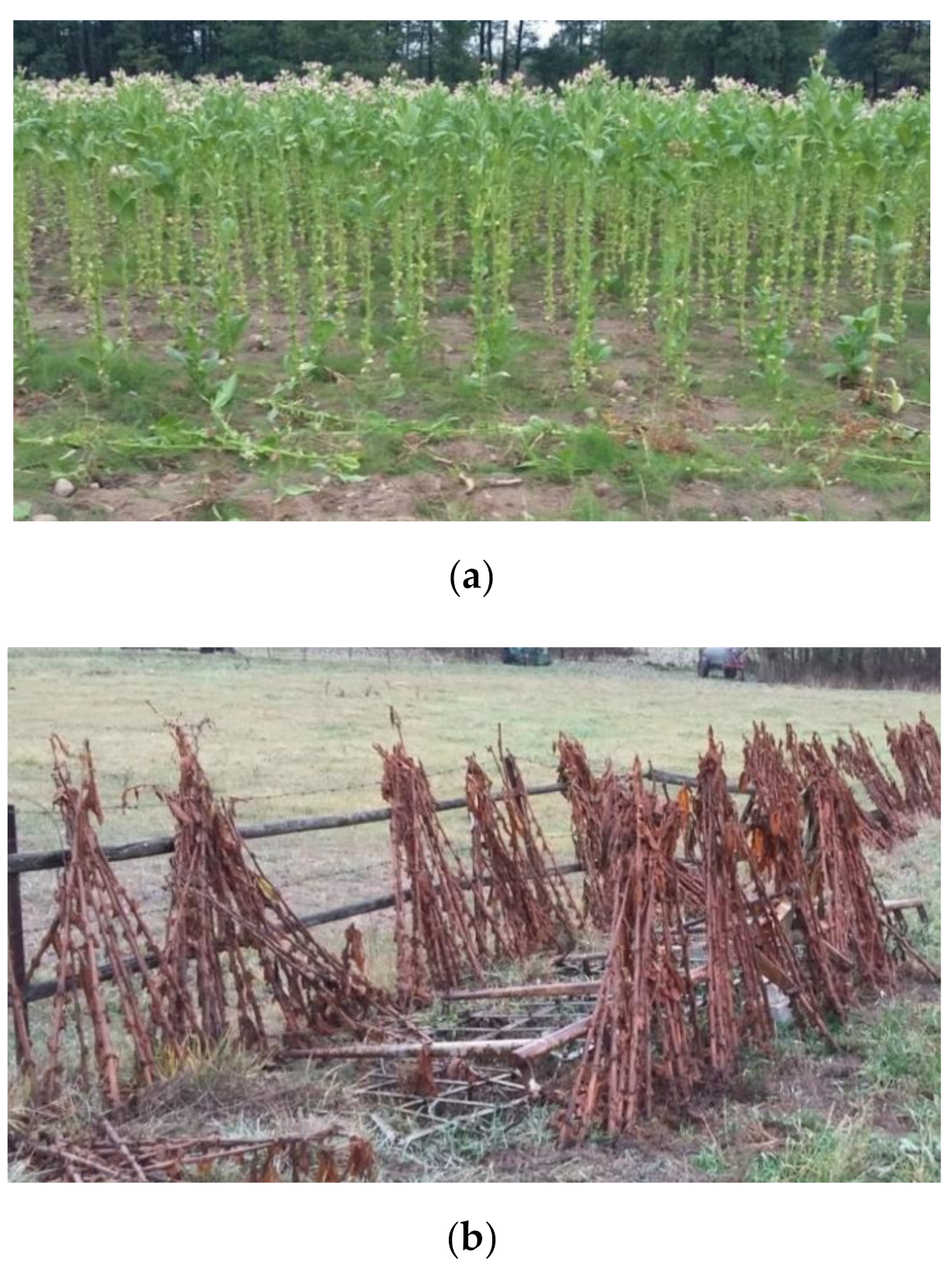
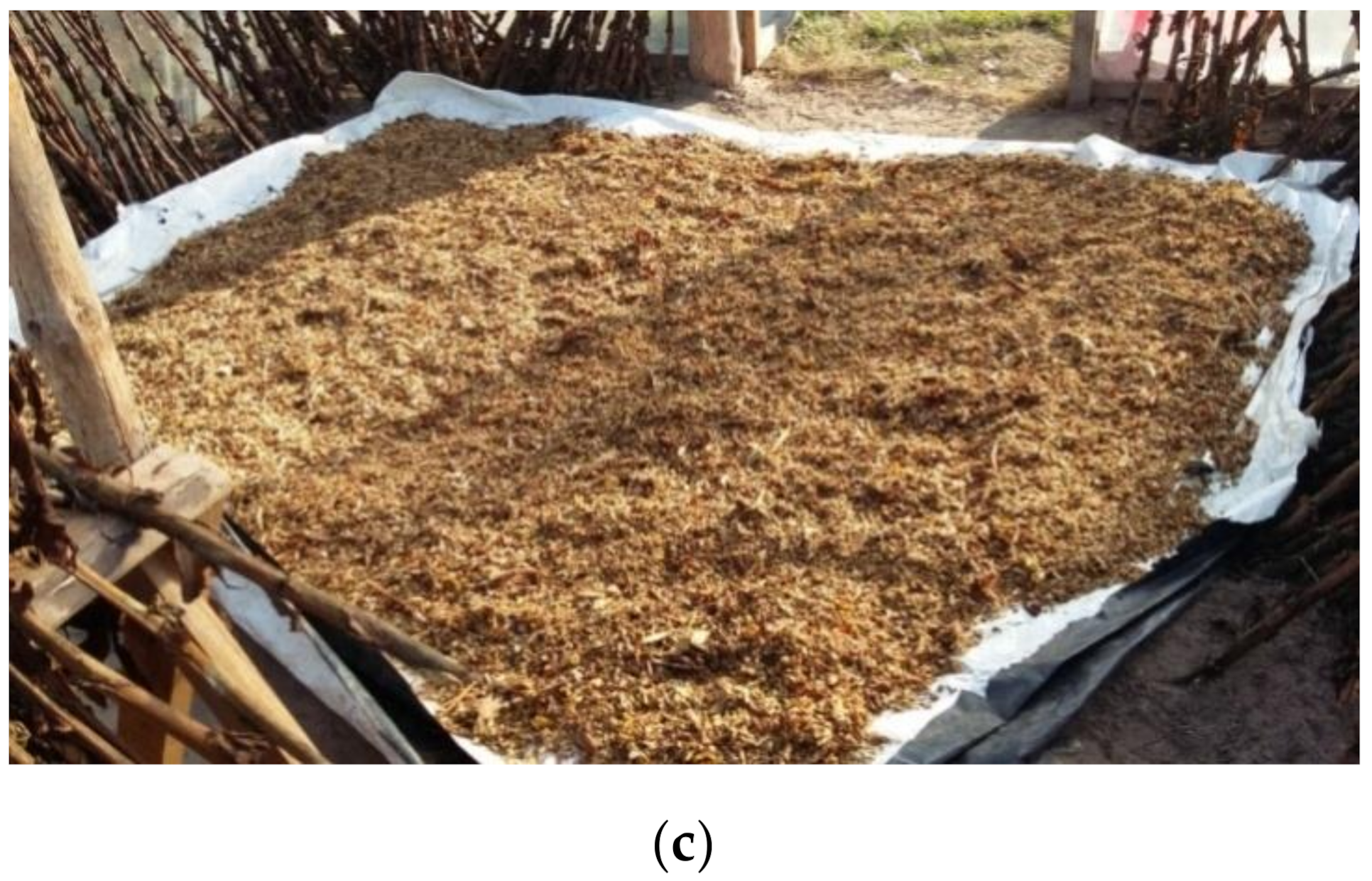
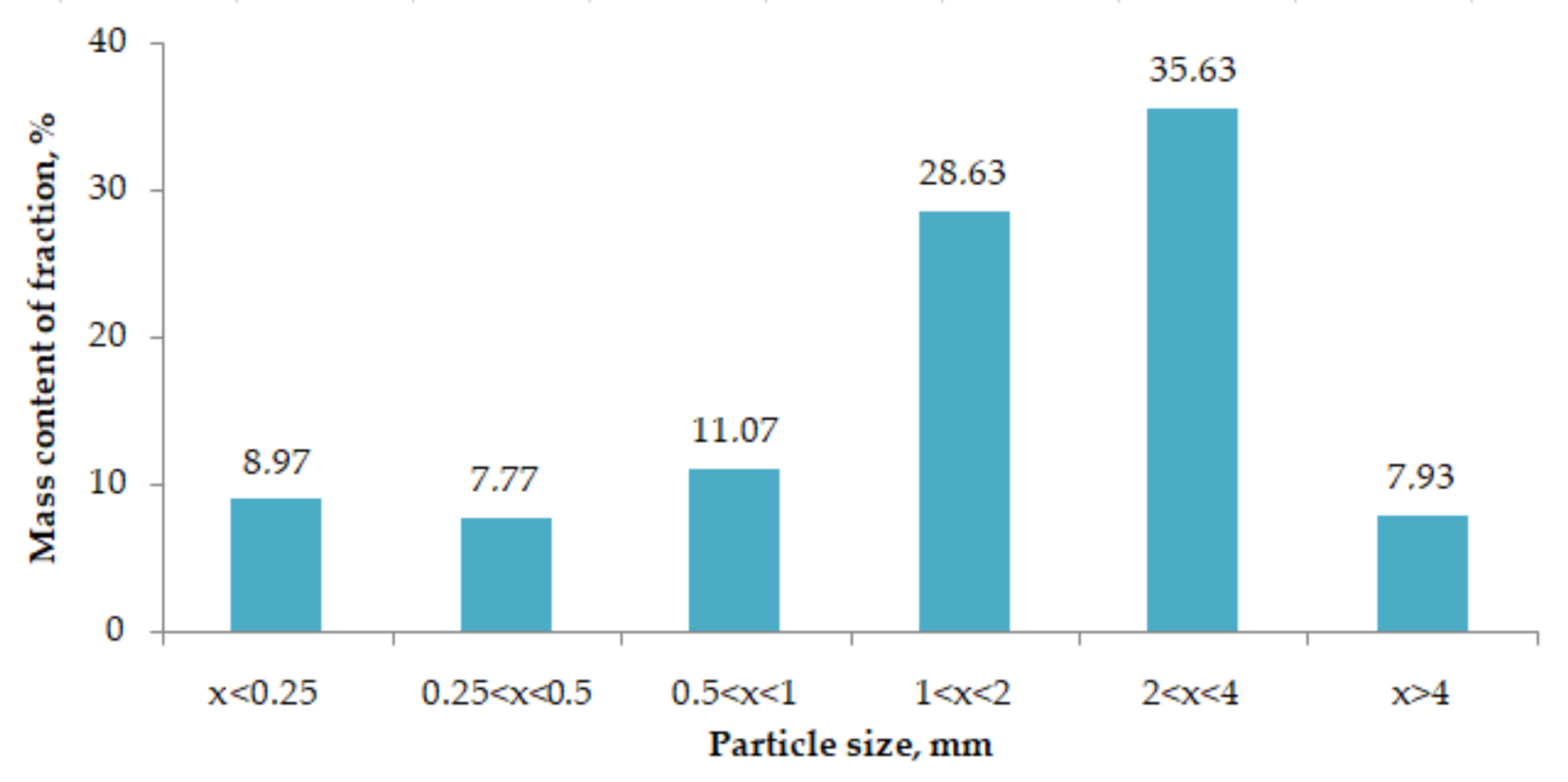

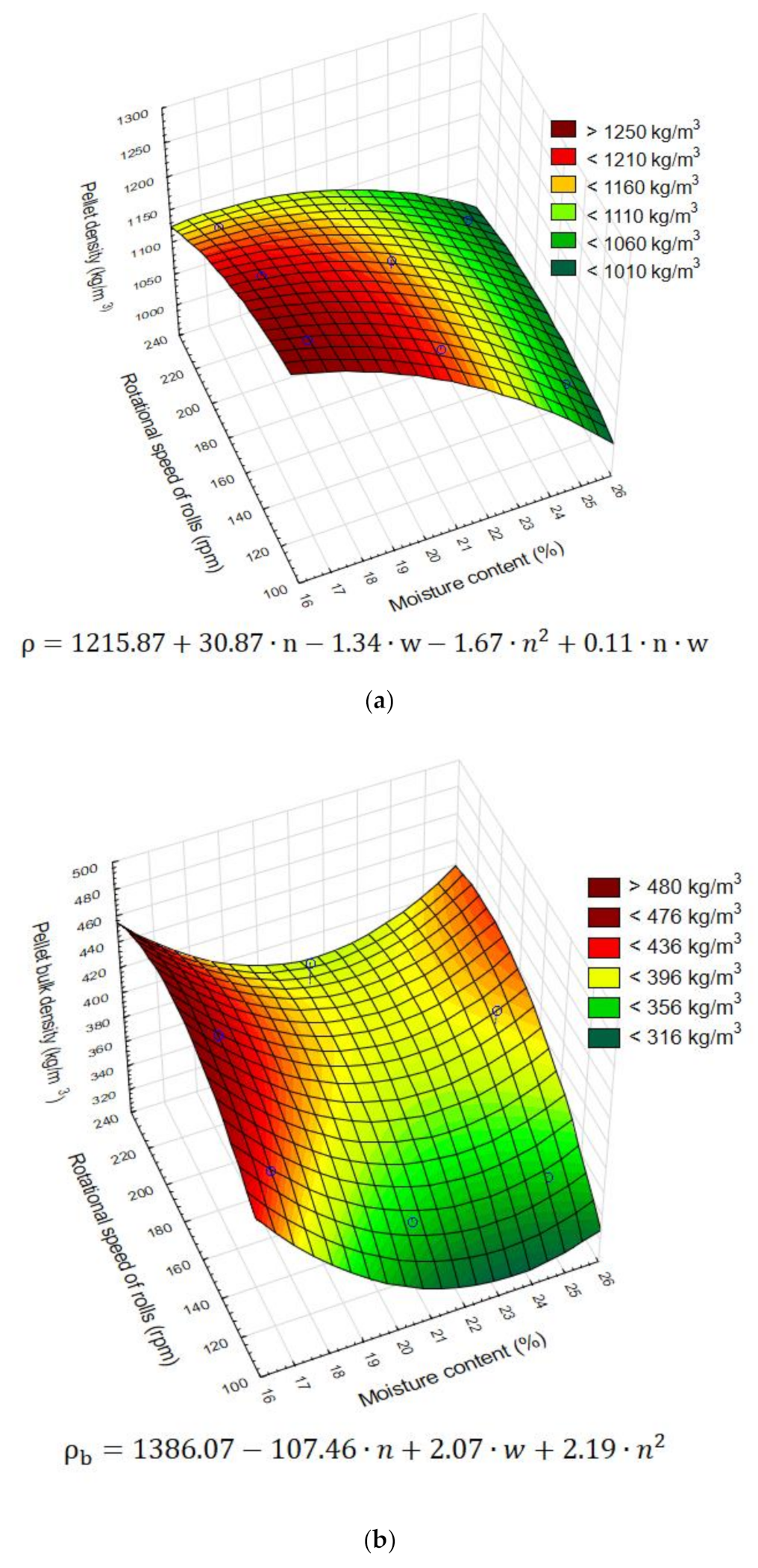
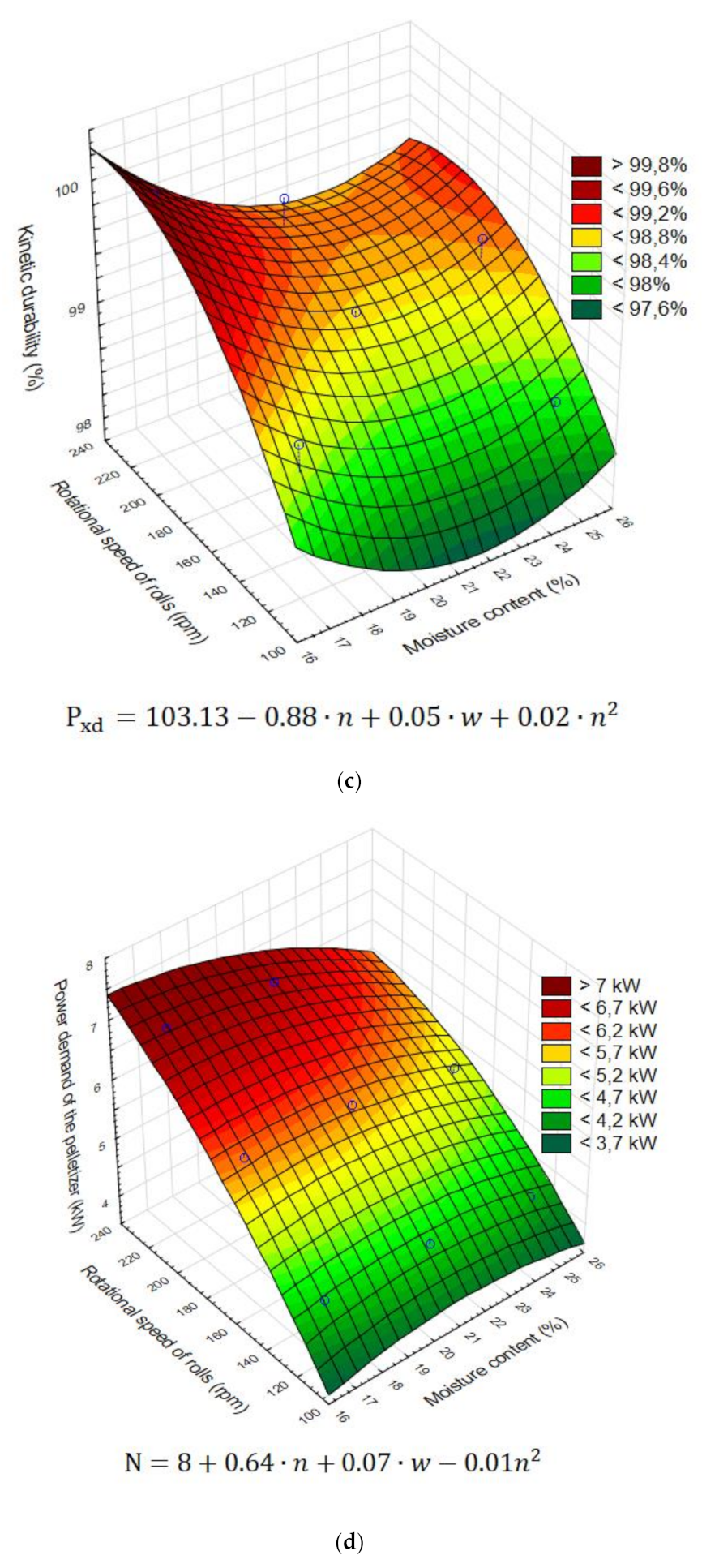
| Parameter | Value |
|---|---|
| Proximate analysis (a.r.) (%wt.) | |
| Moisture | 4.65 |
| Volatile matter | 64.54 |
| Ash | 14.67 |
| Fixed carbon † | 16.14 |
| Ultimate analysis (d.b.) (%wt.) | |
| C | 40.54 |
| H | 6.00 |
| N | 1.28 |
| S | 0.262 |
| Cl | 0.087 |
| O † | 37.16 |
| Metals (d.b.) (μg·g−1) | |
| Cr | 1.17 |
| Mn | 80.26 |
| Fe | 458.7 |
| Ni | 14.97 |
| Cu | 31.49 |
| Zn | 36.55 |
| Pb | 0.76 |
| Al | 2033 |
| AAEMs ††(d.b.) (μg·g−1) | |
| Ca | 8391 |
| Mg | 3961 |
| K | 24.978 |
| Na | 132 |
| Non-metals (d.b.) (μg·g−1) | |
| P | 2359 |
| HHV ††† (a.r.) (MJ·kg−1) | 15.18 |
| FVI (-) | 0.09–0.12 |
| Moisture Content (%) | HHV (MJ·kg−1) | LHV(MJ·kg−1) |
|---|---|---|
| 0 | 18.02 | 16.02 |
| 6.71 | 16.81 | 14.78 |
| 10 | 16.22 | 14.17 |
| 20 | 14.42 | 12.33 |
| 30 | 12.62 | 10.48 |
| Independent Variables | Dependent Variables | |||||
|---|---|---|---|---|---|---|
| x1 = w (%) | x2 = n (rpm) | ρ(kg·m−3) ± SD | ρb(kg·m−3) ± SD | Pdx(%) ± SD | N (kW) | |
| 1. | 17 | 120 | 1260 ± 21.13 | 430 ± 0.73 | 98.7 ± 0.2 | 4.58 |
| 2. | 21 | 120 | 1180 ± 23.56 | 350 ± 4.28 | 97.7 ± 1.2 | 4.52 |
| 3. | 25 | 120 | 1060 ± 25.21 | 350 ± 9.77 | 98.2 ± 1.1 | 4.32 |
| 4. | 17 | 170 | 1220 ± 32.06 | 460 ± 2.27 | 99.1 ± 0.2 | 5.91 |
| 5. | 21 | 170 | 1180 ± 30.46 | 380 ± 2.66 | 98.8 ± 0.5 | 5.84 |
| 6. | 25 | 170 | 1050 ± 34.13 | 410 ± 3.54 | 99.0 ± 0.5 | 5.53 |
| 7. | 17 | 220 | 1160 ± 32.25 | 440 ± 0.31 | 99.6 ± 0.3 | 7.04 |
| 8. | 21 | 220 | 1120 ± 36.21 | 410 ± 7.07 | 99.2 ± 0.1 | 6.91 |
| 9. | 25 | 220 | 1050 ± 38.12 | 400 ± 5.26 | 98.8 ± 0.2 | 5.94 |
| Parameter | Value | ||
|---|---|---|---|
| Tobacco Stalk Pellets | Industrial Wood Pellets [43] | Ecodesign Limitations | |
| CO2(%) | 3.52 | 7.27 | - |
| CO (mg·Nm−3) | 8243.28 | 329.87 | 500 |
| SO2 (mg·Nm−3) | 153.08 | 2.87 | - |
| NO (mg·Nm−3) | 224.34 | 50.85 | 200 |
| HCl (mg·Nm−3) | 44.79 | 0.00 | - |
| The actual oxygen concentration in the exhaust (%) | 13.35 | 9.14 | - |
| λ (–) | 2.63 | 1.74 | - |
| Average flue gas temperature in the boiler outlet (°C) | 120 | 170 | - |
Publisher’s Note: MDPI stays neutral with regard to jurisdictional claims in published maps and institutional affiliations. |
© 2020 by the authors. Licensee MDPI, Basel, Switzerland. This article is an open access article distributed under the terms and conditions of the Creative Commons Attribution (CC BY) license (http://creativecommons.org/licenses/by/4.0/).
Share and Cite
Obidziński, S.; Puchlik, M.; Dołżyńska, M. Pelletization of Post-Harvest Tobacco Waste and Investigation of Flue Gas Emissions from Pellet Combustion. Energies 2020, 13, 6002. https://doi.org/10.3390/en13226002
Obidziński S, Puchlik M, Dołżyńska M. Pelletization of Post-Harvest Tobacco Waste and Investigation of Flue Gas Emissions from Pellet Combustion. Energies. 2020; 13(22):6002. https://doi.org/10.3390/en13226002
Chicago/Turabian StyleObidziński, Sławomir, Michał Puchlik, and Magdalena Dołżyńska. 2020. "Pelletization of Post-Harvest Tobacco Waste and Investigation of Flue Gas Emissions from Pellet Combustion" Energies 13, no. 22: 6002. https://doi.org/10.3390/en13226002
APA StyleObidziński, S., Puchlik, M., & Dołżyńska, M. (2020). Pelletization of Post-Harvest Tobacco Waste and Investigation of Flue Gas Emissions from Pellet Combustion. Energies, 13(22), 6002. https://doi.org/10.3390/en13226002






